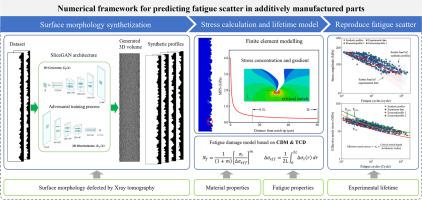当前位置:
X-MOL 学术
›
Int. J. Mech. Sci.
›
论文详情
Our official English website, www.x-mol.net, welcomes your feedback! (Note: you will need to create a separate account there.)
Numerical framework for predicting fatigue scatter in additively manufactured parts
International Journal of Mechanical Sciences ( IF 7.1 ) Pub Date : 2024-07-11 , DOI: 10.1016/j.ijmecsci.2024.109562 Yixuan Hou , Steve Kench , Tony Wauters , Reza Talemi
International Journal of Mechanical Sciences ( IF 7.1 ) Pub Date : 2024-07-11 , DOI: 10.1016/j.ijmecsci.2024.109562 Yixuan Hou , Steve Kench , Tony Wauters , Reza Talemi

|
The layer-based deposition mechanism during electron beam powder bed fusion (PBF-EB) inevitably induces significant surface irregularities, which often act as stress concentrators under cyclic fatigue load, resulting in early fatigue failure and scattered lifetime. Reliable design of additively manufactured metallic lattice structures necessitates a comprehensive understanding of the fatigue behaviour of micro-sized structural parts, typically obtained through expensive and time-consuming full-scale fatigue testing. This study proposed a deep learning-based framework to predict defect-induced fatigue scatter in micro-sized as-built titanium parts produced with PBF-EB technique. The surface morphology synthesized by generative adversarial networks (GANs) was incorporated with finite element modelling to investigate defect-induced stress concentrations. A fatigue damage model, based on continuum damage mechanics and theory of critical distances, was developed to predict fatigue lifetime. The synthesized morphology showed good agreement with experimental results in roughness evaluation. Using the proposed framework, the fatigue scatter was successfully reproduced, and a probabilistic lifetime design curve was developed accordingly to facilitate reliable and cost-effective fatigue design. The primary contributions of this study are the first-time application of a GAN architecture for synthesizing realistic morphology of micro-sized as-built PBF-EB Ti6Al4V parts with significant surface irregularities, and the investigation of defect-induced fatigue scatter using synthetic morphology and numerical methods. The results provide new insights into the effects of surface irregularity on stress concentration and scattering of lifetime in micro-sized as-built titanium parts.
中文翻译:

用于预测增材制造零件疲劳分散的数值框架
电子束粉末床熔合(PBF-EB)过程中的层状沉积机制不可避免地会引起明显的表面不规则性,这些不规则性通常在循环疲劳载荷下充当应力集中器,导致早期疲劳失效和分散的寿命。增材制造金属晶格结构的可靠设计需要全面了解微型结构零件的疲劳行为,这通常是通过昂贵且耗时的全面疲劳测试获得的。本研究提出了一种基于深度学习的框架,用于预测采用 PBF-EB 技术生产的微型钛合金零件中缺陷引起的疲劳散射。将生成对抗网络 (GAN) 合成的表面形态与有限元模型相结合,以研究缺陷引起的应力集中。基于连续损伤力学和临界距离理论,开发了疲劳损伤模型来预测疲劳寿命。合成的形貌与粗糙度评价的实验结果表现出良好的一致性。使用所提出的框架,成功地再现了疲劳分散,并相应地开发了概率寿命设计曲线,以促进可靠且具有成本效益的疲劳设计。这项研究的主要贡献是首次应用 GAN 架构来合成具有显着表面不规则性的微米尺寸竣工 PBF-EB Ti6Al4V 零件的真实形态,以及使用合成形态和研究缺陷引起的疲劳散射数值方法。这些结果为微型钛合金零件表面不规则性对应力集中和寿命分散的影响提供了新的见解。
更新日期:2024-07-11
中文翻译:

用于预测增材制造零件疲劳分散的数值框架
电子束粉末床熔合(PBF-EB)过程中的层状沉积机制不可避免地会引起明显的表面不规则性,这些不规则性通常在循环疲劳载荷下充当应力集中器,导致早期疲劳失效和分散的寿命。增材制造金属晶格结构的可靠设计需要全面了解微型结构零件的疲劳行为,这通常是通过昂贵且耗时的全面疲劳测试获得的。本研究提出了一种基于深度学习的框架,用于预测采用 PBF-EB 技术生产的微型钛合金零件中缺陷引起的疲劳散射。将生成对抗网络 (GAN) 合成的表面形态与有限元模型相结合,以研究缺陷引起的应力集中。基于连续损伤力学和临界距离理论,开发了疲劳损伤模型来预测疲劳寿命。合成的形貌与粗糙度评价的实验结果表现出良好的一致性。使用所提出的框架,成功地再现了疲劳分散,并相应地开发了概率寿命设计曲线,以促进可靠且具有成本效益的疲劳设计。这项研究的主要贡献是首次应用 GAN 架构来合成具有显着表面不规则性的微米尺寸竣工 PBF-EB Ti6Al4V 零件的真实形态,以及使用合成形态和研究缺陷引起的疲劳散射数值方法。这些结果为微型钛合金零件表面不规则性对应力集中和寿命分散的影响提供了新的见解。












































 京公网安备 11010802027423号
京公网安备 11010802027423号